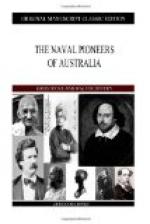[Illustration: WRECK REEF. From an engraving by John Pye, after a drawing by W. Westall, A.R.A. From Flinders’ “Voyage to Terra Australia” [London, 1814]. To face p. 192.]
The Hope reached Sydney safely on the 8th September, and Flinders and his companions went straight to Government House, where King was having dinner. The Governor leapt from his chair with astonishment, almost taking them for spectres, so half starved and distressing was their appearance.
“But,” says Flinders, “as soon as he was convinced of the truth of the vision, and learned the melancholy cause, a tear started from the eye of friendship and compassion, and we were received in the most affectionate manner.”
Alas for poor Flinders! There were yet in store for him worse miseries, and tears of sorrow from those nearer and dearer to him were yet to flow in abundance in the many weary years of waiting yet to come.
CHAPTER IX.
THE CAPTIVITY OF FLINDERS
In Governor King, Flinders had a firm friend, and one who sympathized deeply with his misfortune, as was soon evinced. But the first thing to be done was to rescue the castaways on Wreck Reef, as Flinders had named the scene of the disaster, and the master of the ship Rolla, bound to China, was engaged by King to call at the reef with provisions and convey to Canton all those of the ships’ companies who preferred going to that port; and the Francis, a schooner of 40 tons, sent in frame from England in 1792, was to accompany the Rolla and bring back those of the shipwrecked men who chose to return to Port Jackson.
But for Flinders himself King did more: he offered him the use of a small vessel to sail to England to convey home the charts and journals of the Investigator voyage. The vessel was named the Cumberland; she was only 29 tons, and had been built in Sydney, but Flinders was satisfied that she was capable of performing the voyage; and both he and King, being men of action, decided that she should sail, in company with the Francis and Rolla, to the scene of the wreck, where Flinders was to select officers and men to man her for the voyage to England, a temporary crew being given him for the run down to the reef. King told Flinders to choose his own route for the voyage home, to sell the little vessel at the Cape or elsewhere if he thought fit, and engage another to continue the voyage, and, in fact, gave his friend a free hand.
The Australian press of the day consisted of the Sydney Gazette, then in its first year of existence, and sometimes printed on odd scraps of wrapping paper by reason of the shortness of other material, and this paper, speaking of the Cumberland, says, “She is a very good sea-boat, and in every way capable of carrying enough water and provisions for Captain Flinders and the officers and nine men who are appointed to navigate the first vessel built in the colony to England.”




